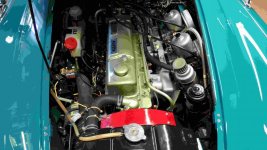Offline
Trying to post, computer malfunction.
Not sure what you mean here; do you mean the hose was stuck in the air filter to filter the gases from the crankcase exiting to the atmosphere (because that's that all an air filter on the 'T' will do, and why a catch can is a better solution)? The vent in the stock (Cooper?) rear filter of a Big Healey is flattened and opens as a 'slot' right next to the mouth of the carburettor; I believe there is significant suction at this point due to the venturi effect,
- the hose is in the air cleaner to facilitate filtered air being drawn into the crankcase. the venturi effect is not stong enough on this hose end at the filter to suck from the hose down the carb. Yes some of course get down the carb, but it is minor compared to a direct draw on the hose. Stop and think about it, the square area of the filter element is providing air to the carb. How can you believe that the hose is providing much of the air volume going down the carb. Also the nipple of the hose inside the air filter is positioned INSIDE THE PERIMETER OF THE FILTER ELEMENT. If the intent was to pull air out of the crankcase and down the carb don't you think it would be a good idea to have the hose positioned so that the air coming out of the crankcase would be drawn thru the filter element itself to try to stop debris from coming from the crank case and down the carb.
either inside the air filter or directly through a separate port.
On every stock PCV valve arrangement I've seen the gases from the crankcase are vented by the PCV valve directly into the intake manifold,either inside the air filter or directly through a separate port.
- Yes "into the intake manifold". and below the throttle plate. this is a vacuum source. A true PCV system never has its pcv valve stuck into an Air Cleaner. There is no vacuum there, it is above the throttle plates. What ever hose is found in a air cleaner is there as the air entry point to the crankcase. The hose is in the air cleaner so that any air drawn into the crankcase will be filtered. That's why I have been saying that the hose on the Healey from the Tee to the rear carb is acting as a two way street. There is no other opening into the crankcase of a Healey 3000, or a 100/6. Therefore there is no crankcase recirculation, only an opening to the atmosphere. One opening.
Some crankcase atmosphere does get pushed up the hose to the rear carb, that's why the carb gets oily. But this is not a perfect system. it's the only opening in the crankcase. If you take the hose off the rear carb and put your finger over the end of it while the engine is running you will feel some pressure. So some people think , well, that's the air coming out of the crankcase. Well sure it is, but is the carb now pulling it out. the hose is in your hand not in the air filter. Stop and think about all the turbulence that is going on in the crankcase even when the engine is idling. The air has to go somewhere, and your holding it in your hand. It's the only opening, and it's a two way street, allowing some in and some out. The Carb and air filter isn't pulling it. And that one two way street opening is restrictive. It allows pressure to be greater than if there was better venting of the crankcase. Well, just a 2" circular filter on the end of the Tee allows better venting, and my rear main seal stopped leaking. And my rear carb stays as clean as the front one, and the little 2" filter on the end of the Tee doesn't get oil saturated in the whole summer of driving. What makes you think I need a catch can.
either inside the air filter or directly through a separate port. The intake air to supply the PCV circuit was always filtered from inside the air filter or by a separate--usually valve cover-mounted--filter. Unfiltered crankcase gases ported directly to the intake manifold have always been a bit of a problem; my Ranger's throttle would get sticky every 20K miles or so due to the accumulation of gunk from the PCV valve. Newer engines with direct injection can be even more problematic, as you don't get the benefit of the 'miracle' cleaners--Techron, V-Power, etc.--at least partially cleaning the intake ports and the backside of the intake valves (this is why some Toyota DI engines have an additional port injector to help keep the intake valves from gunking up).

 Hi Guest!
Hi Guest!

 smilie in place of the real @
smilie in place of the real @
 Pretty Please - add it to our Events forum(s) and add to the calendar! >>
Pretty Please - add it to our Events forum(s) and add to the calendar! >> 

